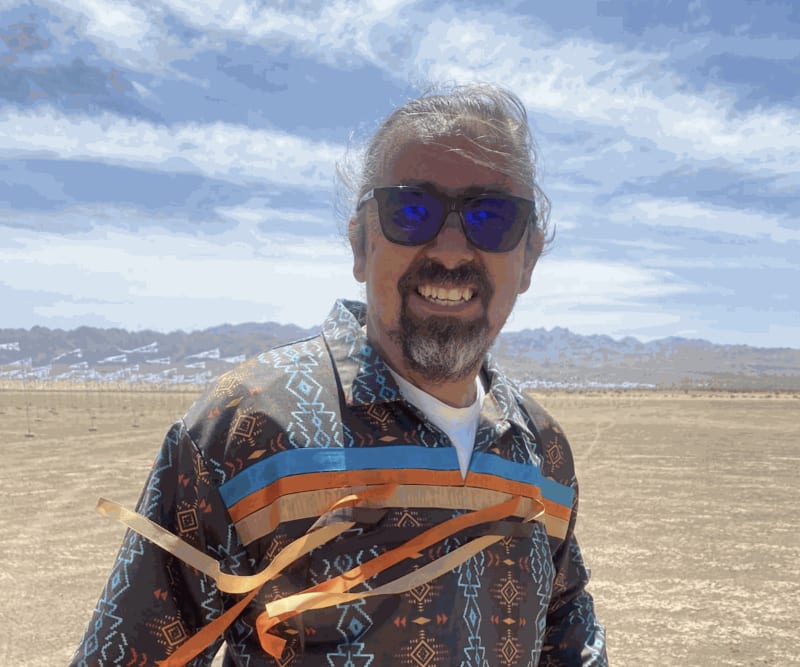Well, there's a danger for contemporary Native artists to fall into the trap of making all your artwork to kind of straighten white people out. Before you know it, you forget: "What about my own people?" So I do a little bit of both. People like the Continuum baskets. They're decorative, and they look like large baskets or beadwork, but the fact is, they're (made with) beer cans and soda cans. I'm also talking about alcoholism; I'm talking about diabetes within the community.
Those are kind of negative things, but you step back, and you look at the whole community, and (the community as a whole) is a beautiful thing. So I try to engage both audiences. I'm really passionate about wanting to be part of my community and wanting to be respected. I want my community to also take ownership and pride in the work that I do.
Are there other Native artists helping carry this torch?
Actually, indigeneity is hot right now, with Reservation Dogs on Hulu and FX, and Killers of the Flower Moon just got some nominations … and there are a lot of Native artists who are jumping on opportunities that we never had before.
Still, if you want to make it big as a Native artist, you've got to go to Sante Fe or something, and I've resisted that completely. It's not like I'm against showing work out; I have work at the National Gallery (of Art) in a group show in Washington, D.C. But I'm intimately connected to my community, not just as an artist, but as a community member. First and foremost, they're my targeted audience. That doesn't mean I don't have ideas to share with the world. But if I'm not making art for my community, who is? The answer is nobody.
The art world is increasingly going global. Intersect and other large festivals like Art Basel pull international crowds of art-lovers. You've expressed a need to keep local culture in focus. Why?
It's not just the arts. It's Western culture, American culture, European culture, the art world and beyond-academia as well-that has pushed this kind of narrative that somehow, global knowledge and global expression is what's important, and nobody's bothering to think that local knowledge is being lost.
As a Native person, I feel this really closely with, like, our Native languages. There are Indigenous languages around the world that are endangered because of this push toward global knowledge and the use of English, or these other major languages.
You know, the history of California is based on mining. They mined the gold; it's on your driver's license. … But the mining never stopped. They mined our people, right? They mined our culture, and now through the arts, they're mining our artists, and they're taking our artists out of our communities.
Do you see a way to balance the need for commercial impact and keeping contemporary art accessible? How would you make art more engaging to the Native community?
I actually like what (the) Agua Caliente (Cultural Museum) has done by including this contemporary space for their people to interact with. Like I said, there are not a lot of contemporary art spaces on Indian reservations. It's a historic museum about the history of their people, right? And I appreciate that. They spared no expense; it's pretty swank, no? But they have that other gallery included, and Horace Poolaw's photographs are in there right now. I really appreciate that they didn't just do the history thing, but they left a space in that building for contemporary work.
What's next for Gerald Clarke? Are there any big installations like "Immersion" on the horizon?
I'm doing an outdoor kind of sculptural work out of fabric that's influenced by the ribbon skirts that my daughters and the Indian women wear when they dance. It's yet untitled, but it's going to be about 21 feet wide. I'm not sure of the depth yet, but probably like 40 to 60 feet long or deep. I guess I would say that's kind of big. It's for a show at the Ontario Museum of Art and History. They actually commissioned it. They have this outdoor space, and I wanted to do something in that space. "Immersion" and this piece, they're all direct expressions of my encounter with the (installation) place.
Gerald Clark will participate in a panel discussion on the unique aspects of the desert light, topography and culture at 4 p.m., Friday, Feb. 9, at Intersect Palm Springs. Intersect Palm Springs starts with an opening-night preview from 6 to 9 p.m., Thursday, Feb. 8, and continues from 10 a.m. to 7 p.m., Friday, Feb. 9; 10 a.m. to 7 p.m., Saturday, Feb. 10, and 11 a.m. to 3 p.m., Sunday, Feb. 11, at the Palm Springs Convention Center, 277 N. Avenida Caballeros.

